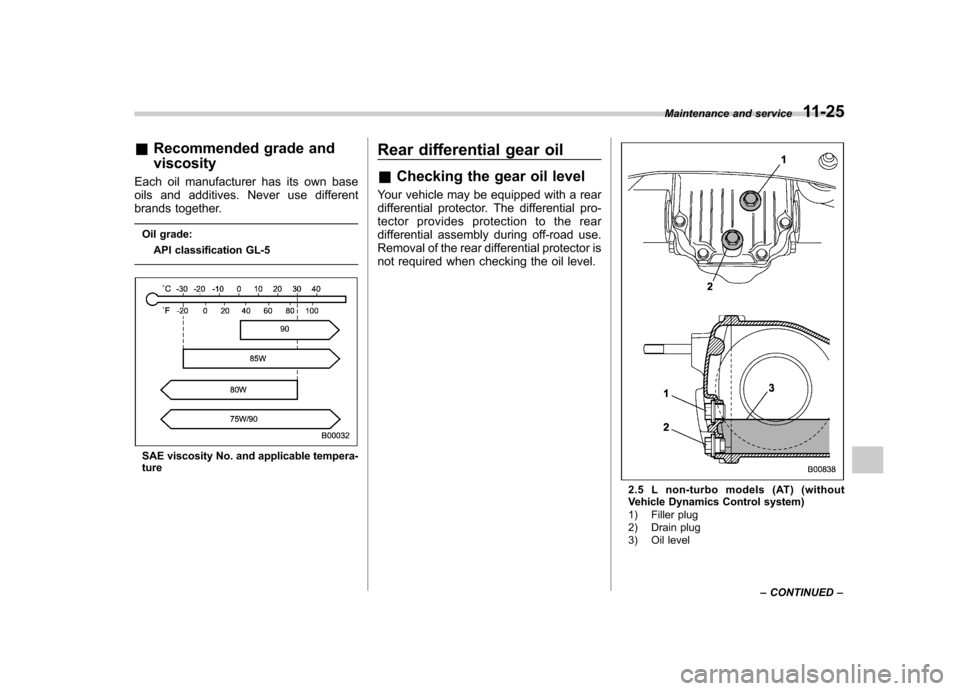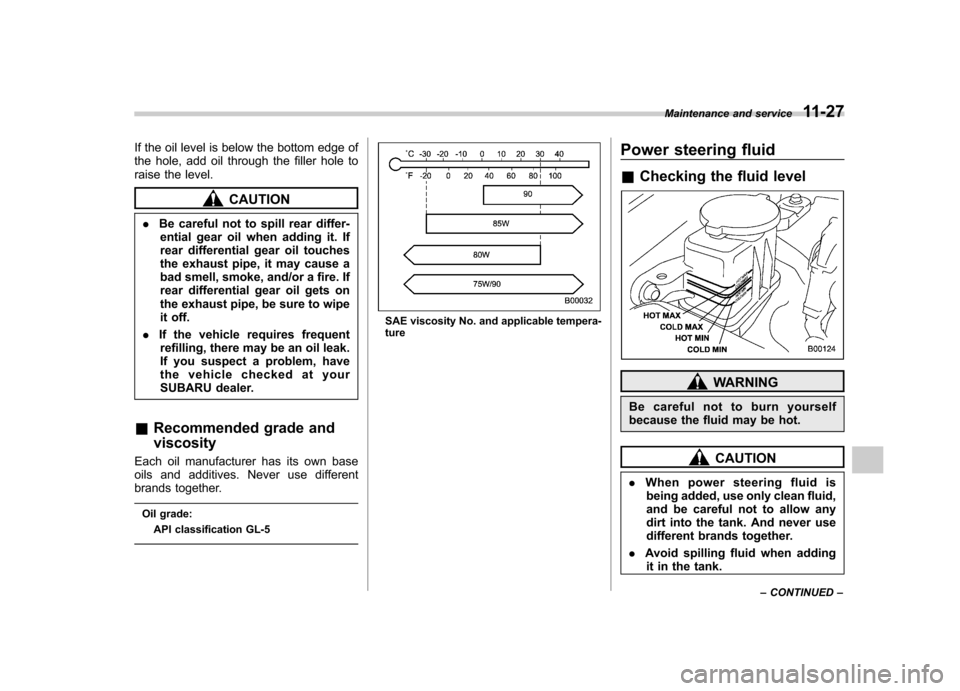2009 SUBARU LEGACY recommended oil
[x] Cancel search: recommended oilPage 374 of 447

11-24Maintenance and service
mance, only use the automatic trans-
mission fluid that is recommended and
provided by SUBARU.
If the recommended automatic trans-
mission fluid is unavailable, Dexron III
may be temporarily used. If the Dexron
III is used continuously there will be a
noticeable increase in the vibration and
noise from the automatic transmission. Front differential gear oil
(AT models) &
Checking the oil level
1) Yellow handle
1. Park the vehicle on a level surface and
stop the engine.
2. Pull out the level gauge, wipe it clean,
and insert it again.
1) Upper level
2) Lower level
3. Pull out the level gauge again and
check the oil level on it. If it is below the
lower level, add oil to bring the level up to
the upper level.
CAUTION
Be careful not to spill front differ-
ential gear oil when adding it. If oil
touches the exhaust pipe, it may
cause a bad smell, smoke, and/or a
fire. If oil gets on the exhaust pipe,
be sure to wipe it off.
Page 375 of 447

&Recommended grade and viscosity
Each oil manufacturer has its own base
oils and additives. Never use different
brands together.
Oil grade: API classification GL-5
SAE viscosity No. and applicable tempera- ture Rear differential gear oil &
Checking the gear oil level
Your vehicle may be equipped with a rear
differential protector. The differential pro-
tector provides protection to the rear
differential assembly during off-road use.
Removal of the rear differential protector is
not required when checking the oil level.
2.5 L non-turbo models (AT) (without
Vehicle Dynamics Control system)
1) Filler plug
2) Drain plug
3) Oil level Maintenance and service
11-25
– CONTINUED –
Page 377 of 447

If the oil level is below the bottom edge of
the hole, add oil through the filler hole to
raise the level.
CAUTION
. Be careful not to spill rear differ-
ential gear oil when adding it. If
rear differential gear oil touches
the exhaust pipe, it may cause a
bad smell, smoke, and/or a fire. If
rear differential gear oil gets on
the exhaust pipe, be sure to wipe
it off.
. If the vehicle requires frequent
refilling, there may be an oil leak.
If you suspect a problem, have
the vehicle checked at your
SUBARU dealer.
& Recommended grade and viscosity
Each oil manufacturer has its own base
oils and additives. Never use different
brands together.
Oil grade: API classification GL-5
SAE viscosity No. and applicable tempera- ture Power steering fluid &
Checking the fluid level
WARNING
Be careful not to burn yourself
because the fluid may be hot.
CAUTION
. When power steering fluid is
being added, use only clean fluid,
and be careful not to allow any
dirt into the tank. And never use
different brands together.
. Avoid spilling fluid when adding
it in the tank. Maintenance and service
11-27
– CONTINUED –
Page 378 of 447

11-28Maintenance and service
.Be careful not to spill power
steering fluid when adding it. If
power steering fluid touches the
exhaust pipe, it may cause a bad
smell, smoke, and/or a fire. If
power steering fluid gets on the
exhaust pipe, be sure to wipe itoff.
The power steering fluid expands greatly
as its temperature rises; the fluid level
differs according to fluid temperature.
Therefore, the reservoir tank has two
different checking ranges for hot and coldfluids.
Check the power steering fluid level
monthly.
1. Park the vehicle on a level surface,
and stop the engine.
2. Check the fluid level of the reservoir tank.
When the fluid is hot after the vehicle has
been run: Check that the oil level isbetween “HOT MIN ”and “HOT MAX ”on
the surface of the reservoir tank.
When the fluid is cool before the vehicle is
run: Check that the oil level is between“ COLD MIN ”and “COLD MAX ”on the
surface of the reservoir tank.
3. If the fluid level is lower than the
applicable “MIN ”line, add the recom- mended fluid as necessary to bring the
level between the
“MIN ”and “MAX ”line.
If the fluid level is extreme low, it may
indicate possible leakage. Consult your
SUBARU dealer for inspection.
& Recommended fluid
Use one of the following types of auto-
matic transmission fluid. –SUBARU ATF Type-HP
– IDEMITSU ATF HP Brake fluid &
Checking the fluid level
WARNING
. Never let brake fluid contact your
eyes because brake fluid can be
harmful to your eyes. If brake
fluid gets in your eyes, immedi-
ately flush them thoroughly with
clean water. For safety, when
performing this work, wearing
eye protection is advisable.
. Brake fluid absorbs moisture
from the air. Any absorbed moist-
ure can cause a dangerous loss
of braking performance.
. If the vehicle requires frequent
refilling, there may be a leak. If
you suspect a problem, have the
vehicle checked at your SUBARU
dealer.
CAUTION
. Never use different brands of
brake fluid together. Also, avoid
mixing DOT 3 and DOT 4 brake
fluids even if they are of the samebrand.
Page 441 of 447

N
New vehicle break-in driving.......................................... 8-2
OOdometer .................................................................. 3-25
Odometer/Trip meter .................................................. 3-10
Off road driving ............................................................ 8-6
Oil filter .................................................................... 11-10
Oil level Engine .................................................................. 11-9
Front differential gear ............................................ 11-24
Manual transmission .............................................. 11-21
Rear differential .................................................... 11-25
Oil pressure warning light ............................................ 3-32
Outside mirrors .......................................................... 3-57
Outside temperature indicator ...................................... 3-42
Overhead console ........................................................ 6-7
Overheating engine .................................................... 9-13
PParking Brake ................................................................... 7-45
Brake stroke ......................................................... 11-33
Light switch ........................................................... 3-48
Tips...................................................................... 7-45
Parking your vehicle ................................................... 7-44
Periodic inspections ..................................................... 8-4
Petrol fuel ................................................................... 7-3
Pocket ........................................................................ 6-8
Power
Door locking switch .................................................. 2-7 Seat
....................................................................... 1-4
Steering ................................................................ 7-34
Steering fluid ........................................................ 11-27
Windows ............................................................... 2-21
Precautions against vehicle modification ................ 1-27, 1-66
Preparing to drive ........................................................ 7-8
Printed antenna ........................................................... 5-2
RRear Combination lights ................................................ 11-53
Gate ............................................................. 2-27, 9-18
Seats ..................................................................... 1-9
Viscous limited slip differential .................................. 7-33
Rear differential Gear oil ............................................................... 11-25
Rear seat
Folding down .......................................................... 1-9
Rear turn signal ........................................................ 11-53
Rear window
Defogger button ..................................................... 3-54
Wiper and washer switch ......................................... 3-53
Wiper blades ........................................................ 11-44
Recommended
Automatic transmission fluid ................................... 11-23
Brake fluid ........................................................... 11-29
Clutch fluid .......................................................... 11-30
OIL grade and viscosity ..................... 11-12, 11-13, 11-22, 11-25, 11-27
Power steering fluid .............................................. 11-28
Spark plugs ......................................................... 11-20 Index
14-7
Page 446 of 447

GAS STATION REFERENCE
& Fuel:
! 2.5 L non-turbo models
Use only unleaded gasoline with an octane rating of 87 AKI or
higher .
! 2.5 L turbo models
Use premium unleaded gasoline with an octane rating of 91
AKI or higher . For temporary purposes if premium unleaded
gasoline is not available, you may use regular unleaded
gasoline with an octane rating of 87 AKI or higher. For optimum
engine performance and driveability, it is required that you use
premium grade unleaded gasoline. ! 3.0 L models
Use unleaded gasoline with an octane rating of 91 AKI or
higher . Regular unleaded gasoline with an octane rating of 87
AKI or higher may be used. However for optimum engine
performance and driveability, it is recommended that you use
91 AKI or higher grade unleaded gasoline. You may experience
reduced output, poor accelerator response, and reduced fuel
economy when using gasoline with an octane rating lower than
91 AKI, depending on your driving habits and conditions. If you
experience any of these conditions while using a lower octane
rated fuel, you may want to return to using 91 AKI octane rated
fuel as soon as possible. Additionally, if your vehicle knocks
heavily or persistently, or if you are driving with heavy loads
such as when towing a trailer, the use of 91 AKI or higher grade
unleaded gasoline is required. &
Fuel octane rating
This octane rating is the average of the Research Octane and
Motor Octane numbers and is commonly referred to as the Anti
Knock Index (AKI). Refer to “Fuel ”section in this manual.
& Fuel capacity:
16.9 US gal (64 liters, 14.1 Imp gal) & Engine oil:
Use only API classification SM with the words “ENERGY
CONSERVING ”or ILSAC GF-4, which can be identified with
the ILSAC certification mark (Starburst mark).& Engine oil capacity:
2.5 L models: 4.2 US qt (4.0 liters, 3.5 Imp qt)
3.0 L models: 5.8 US qt (5.5 liters, 4.8 Imp qt)